
The drill and blast method is used in many quarries to win stone for crushing, but there are alternatives. Patrick Smith reports
European restrictions on blasting operations are now so rigorous that some quarry operators have abandoned the practice in favour of other methods.
One of the major reasons for the regulations is that people living or working near, or even in quarries, could be affected by flying rock, the shock waves from a blast or the noise. Dust could also be problem, and concerns have been expressed about the possible effects on wildlife and the natural environment.
All this can make explosives expensive and more difficult to use, with quarry operators facing large expenditure to comply with the necessary restrictions and regulations. Indeed, some quarries including operations in Spain, Sweden, Italy and the UK, along with some eastern European countries have already found alternative methods for gaining rock.
John Stocker is convinced that his company's decision to move away from the traditional drill and blast method of quarrying stone is a good one, even though its quarries have blasting permissions.
The manager at the
The company has invested heavily in a
Rip and load is one of a number of alternatives to drill and blast. Others include breaking (see also Equipment Focus and Quarry Report) where a hydraulic breaker chips at the rock and produces the desired material, and cutting, which uses a surface miner that is more conventionally used for site levelling. The surface miner's cutting drum passes over the surface of the material, again chipping off rock for processing. Some companies are also producing chemical methods for extraction. This is silent and involves placing a special compound in boreholes, and waiting for it to expand and split the rock.
At the Ardley Quarry, Smiths Bletchington quarries limestone to be processed into aggregates for use in road construction and for fill, and lime for agriculture.
Some years ago it started to look at alternatives to drill and blast (the BPI drill equipment at Ardley is up for sale), mainly on the grounds of economy.
At the existing Ardley site, bounded by the M40 motorway and a main railway line, production focuses on the north quarry, where an estimated 300,000tonnes of rock is left. Quarrying will soon start at the new site, which has an estimated 3.5 million tonnes of limestone and a life of about 20 years.
The rail track owner placed restrictions on blasting, and wanted its staff on site during any blasting (possibly twice a week, 52 weeks of the year).
"We would have been paying for this on top of the cost of using explosives, a very expensive business. This is when the idea came to us to use a ripper. I think eliminating this added cost has nearly paid for the rip and load equipment we bought through
The Caterpillar 365C excavator along with Caterpillar TR-70 ripper and 4.5m³ bucket attachments have quick-hitch connectors, meaning attachments can be changed and ready to use in about 30 seconds. The ripper is mounted onto the excavator and dragged through the base material.
Stocker said that on a good day between 1,750-2,000tonnes is ripped from the quarry face.
"It is probably the best move we have made. The last blasting we did was twice a week and this produced about 4,000tonnes of rock at a time," said Stocker.
A Cat 972G loading shovel is used to feed the in-line
"It is not a particularly hard limestone, and we have two types. Up to 4m down it is quite soft (65kN strength), and below this is a couple of metres of harder limestone of some 100kN strength. These stones are used for gabion baskets for work on rivers and bridges," said Stocker.
The gabion material is between 200-100mm, and other material produced is 150-75mm, 75-40mm, 40-20mm, 20-0mm to dust mixture.
To rip, or not to rip?
Caterpillar says its rippers can be used to rip rock with a high degree of stratification; frequent planes of weaknesses (fractures, faults and laminations); weathering, such as moisture permeated formations; brittleness; low compressive and tensile strength, and low field seismic velocity.
These are the first factors to evaluate in deciding whether ripping is, or is not, possible in a quarry. In marginal cases, evaluating rock rippability may be more complex, and will require further expert advice.
Cat claims that ripping with excavators can improve profit margins, and that using the same excavator to load trucks as well as rip can cut loading costs.
"Ripping allows more selective rock extraction, resulting in better quality product for the crusher, with lower crushing and processing costs. In the right conditions, ripping as an alternative to blasting can considerably reduce the cost per tonne of aggregate produced," says the company.
Heavyweight contenders
The reasons for encouraging the use of heavy hammers to replace explosives in quarries are mainly those of environmental regulations, but also of cost reduction.
The process of rock breaking with mobile hydraulic hammers, more traditionally used for secondary breaking of large blocks, is becoming increasingly popular, and according to some experts can increase productivity because of greater control over the material being quarried. It can also remove the need for secondary breaking prior to crushing.
Some years ago a study included a report on a quarry in Sweden that had opted for a new generation of hydraulic hammer that could break approximately 270-470tonnes/hr of hard rocks at the face. It pointed out that the vibrosilenced version selected was particularly silent (85 dB(A) when measured at distance of 10m: it also limited vibrations.
Even if production with this kind of equipment is relatively low (in comparison to blasting) and ideal for small to medium sized quarries, the new method is said to be particularly environmentally friendly.
"Above all, the adverse effects of blasting such as vibrations, sporadic noise and even the projections of stone are no longer experienced. Local residents and the local authorities are satisfied with the improvements," said the report.
"Due to the quality of breaking (producing a homogenous granulometry between 200 and 400mm) the subsequent operations of crushing have been simplified by the suppression of a jaw crusher.
"The production of fine materials and dusts has been reduced from 12% to 2%, a plus for air quality around the quarry." Because the new benches were only 5m high compared to the traditional benches of 12-20m generated by blasts, future landscaping of the quarry will be more level. @@@ The quarry manager announced a reduction of 55% in cost per tonne of crushed granite, and said it was possible to raise production from 600,000tonnes to 750,000tonnes.










